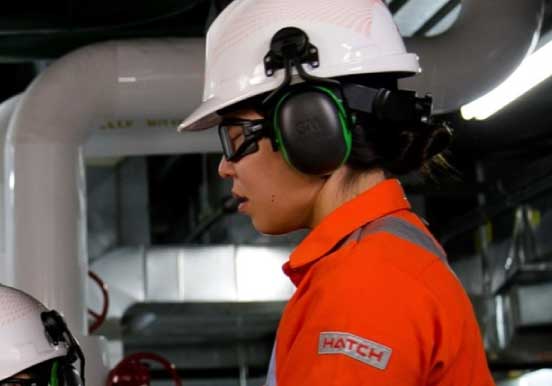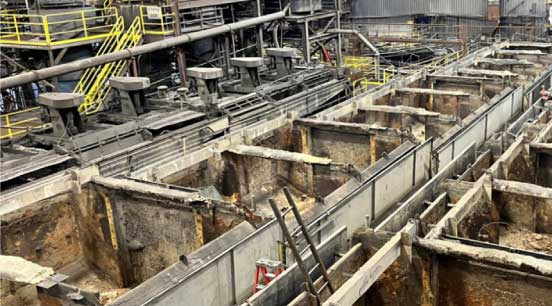Services
- Corrosion risk assessments and damage mechanism review
- Corrosion inspection, monitoring, and mitigation
- Steel and concrete durability assessments and rehabilitation strategies
- Material selection and trade-off analysis
- Material, corrosion, and chemical testing
- Cathodic protection and protective coatings
- Stray current surveys and mitigation
- Asset condition assessments
- Asset integrity management and risk-based inspection
- Failure mode and effect analysis
- Forensic engineering and failure analysis.
Corrosion risk assessments and damage mechanism review
We conduct comprehensive assessments to identify potential corrosion risks and understand the underlying damage mechanisms affecting your assets. This involves analyzing environmental factors, material properties, operating conditions, and historical data to develop effective mitigation strategies.
Corrosion inspection, monitoring, and mitigation
Our team employs a range of inspection and testing techniques, including visual inspections, non-destructive testing (NDT), and advanced imaging technologies, to accurately assess corrosion damage. Corrosion monitoring systems are implemented to track corrosion rates and trends over time, allowing for proactive mitigation measures to be implemented.
Asset integrity management and risk-based inspection
Our team develops tailored integrity management plans and risk-based inspection programs to ensure the continued safe and reliable operation of your assets. This includes identifying potential failure modes, assessing associated risks, and implementing mitigation measures to minimize the likelihood of failures.

Steel and concrete durability assessments and rehabilitation strategies
Utilizing a risk-based approach, we assess the durability of steel and concrete through various testing methods, such as corrosion potential measurements, half-cell potential surveys, ground penetrating radar, chloride ingress testing, etc. Based on the findings we carry out a fitness-for-service assessment and develop rehabilitation strategies, such as surface treatments, repair materials, cathodic protection, and protective coatings and health monitoring plans to extend the service life of your assets.
Material selection and trade-off analysis
Our team of material engineers and scientists provide guidance on selecting the most suitable materials for your specific application, considering factors such as mechanical properties, corrosion resistance, cost-effectiveness, and sustainability. We conduct tradeoff analyses to weigh the pros and cons of different material options, ensuring optimal performance and longevity.
Material, corrosion, and chemical testing
We offer a wide range of testing services to evaluate material properties, corrosion behavior, and chemical compatibility. This includes mechanical testing, chemical analysis, corrosion testing (e.g., salt spray testing, autoclave testing, electrochemical corrosion testing, etc.), and compatibility testing for materials in aggressive environments.
Cathodic protection and protective coatings
Our team designs and installs cathodic protection systems to mitigate corrosion on buried or submerged metallic or concrete structures. We also provide expertise in selecting and applying protective coatings, such as paints and polymers to enhance corrosion resistance.
Stray current surveys and mitigation
We understand the detrimental impact that stray electrical currents can have on metallic structures, leading to corrosion and degradation. That’s why we offer comprehensive stray current surveys, monitoring, and mitigation services to identify, assess, and mitigate the risks associated with stray currents. Our experienced team utilizes state-of-art equipment and methodologies to conduct through surveys, mapping out stray current patterns and pinpointing areas of concern. With our expertise in stray current mitigation techniques, we develop tailored solutions to effectively mitigate the effects of stray currents, ensuring long-term integrity and reliability of your infrastructure.
Asset condition assessments
We conduct thorough assessments of asset condition using visual inspections, structural analysis, and non-destructive testing techniques. This allows us to identify areas of concern, prioritize maintenance activities, and develop cost-effective asset management strategies to optimize performance and reliability.

Failure mode and effect analysis
We conduct failure mode and effect analysis (FMEA) to systematically identify and assess potential failure modes of critical assets. By understanding the root causes of failures, we can recommend preventive measures and design improvements to enhance reliability and safety.
Forensic engineering and failure analysis
In the event of a failure, our forensic engineering experts investigate the incident to determine the root causes and contributing factors. This involves analyzing failed components, conducting material testing, and reconstructing the failure scenario to provide actionable recommendations for prevention in the future.
By offering these comprehensive services, our materials and corrosion team strives to be your trusted partner in protecting and optimizing the performance of your assets across various industries.

